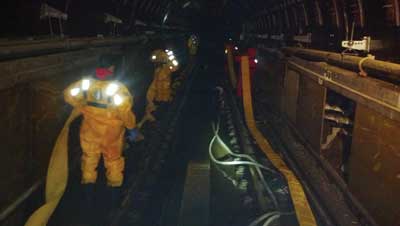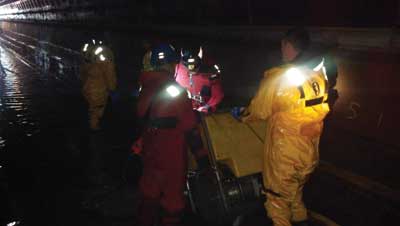BY JOSEPH R. DOWNEY
 |
| PATH dewatering operations: (1) The use of a wye enabled members to use two five-inch hoses instead of one six-inch hose to remove water. Here, they are laying hose adjacent to the tracks on both sides of the tube. (Photos by author.) |
On Saturday November 3, 2012, five days after Hurricane Sandy flooded New York City (NYC), the chief of rescue operations was directed by the Fire Department of New York (FDNY) chief of operations to respond to the Exchange Place PATH station in Jersey City, New Jersey, to evaluate the water condition in the PATH Tubes running from Jersey City to the World Trade Center (WTC). The tracks cross the Hudson River for a distance of one mile through century-old cast iron tubes that rest on the river bottom under a thin layer of silt.
During Hurricane Sandy, the Hudson River surged onto West Street in lower Manhattan near the WTC, and millions of gallons of water cascaded into the 9/11 Memorial footprint and flowed into the PATH tubes. These are the same PATH tubes that suffered tremendous water damage on September 11, 2001. Water filled the two tunnels from the WTC station to Exchange Place in Jersey City from track bed to tunnel ceiling.
On arrival at Exchange Place, it was determined that the Special Operations Command (SOC) would make available to the Port Authority a 3,000-gallon-per-minute (gpm) hydraulic-driven portable submersible floating pump powered by a diesel hydraulic power pack. Specially trained SOC members used 10,000 feet of hose to pump what turned out to be approximately five million gallons of water in the flooded F Line tube.
 |
| (2) Members used 3,000 gallon-per-minute portable submersible floating pumps; they ultimately removed five million gallons of water in the flood F Line tube. |
FDNY purchased three of the hydraulic-driven portable submersible floating pumps with a high-volume pump unit from a company in the Netherlands after the 9/11 attacks knocked out the hydrant system in lower Manhattan. FDNY was planning to use these pumps if large sections of a hydrant system were destroyed. Water could be drafted from the Hudson or East rivers. Large-diameter hose could be stretched for miles to supply FDNY units with a viable water source. Each unit is designed to deliver 3,000 gpm with a lift of 45 feet. The water is moved to a 3,000-gallon pumper with discharge lines of six-inch hose and is capable of providing a temporary hydrant system or dewatering large areas. The city has more than 35,000 feet of six-inch hose coupled with six-inch storz fittings to supply the various needs for water. The hose has an operating pressure of 200 pounds per square inch (psi) and a service test of 225 psi.
Members of rescue operations had the pump brought into Exchange Place in Jersey City and began the pumping operations at the Exchange Place station, where the water was level with the platform. A private contractor was hired to pump out the E Line running adjacent to the F Line from Exchange Place to the WTC station, which also had five million gallons of water.
Members of rescue operations with scuba and rebreather operations pumped for eight days straight, working around the clock (however, it took months to get the tube cleaned and operational). An FDNY mobile command post was set up outside the Exchange Place station. Each 12-hour operational period included a chief officer with a task force from the SOC consisting of one company officer and five firefighters.
The Port Authority of New York and New Jersey supplied emergency service officers to work with FDNY members. Rebreather operations also provided a standby team to support the rebreather operational component.
The pump, which weighs 6,600 pounds, was put onto a buggy (rail car) with the hydraulic submersible floating pump manually placed 200 feet in front of it. Firefighters in protective dry suits and cold water suits had to walk the submersible floating pump and drag the six-inch hose in chest-high water every time the submersible floating pump was advanced. The pump was able to run for approximately three to four hours before it needed to be refueled. Each time members refueled it, the Rail King (train) was used to push a buggy loaded with 55-gallon drums of diesel to the location where the pump was working. A small generator transferred fuel from the 55-gallon drums to the pump’s tank.
 |
| PATH dewatering operations: (3) The Rail King (train) is transporting 55-gallon drums of diesel for the pumps to the next pump-refilling location. |
Since FDNY was unfamiliar with this task, operational plans and strategies were developed and refined on the spot. Each time the submersible floating pump was advanced farther into the tube, additional lengths of hose were added so water could be pumped back into a utility room at the Exchange Place station. Once the water filled this utility room, which acted as a holding area, it was subsequently pumped up 150 feet back into the Hudson River with the contractor’s pumps.
As members advanced the pump into the PATH tube, water levels in the tunnel created atmospheric challenges. When the pump was advanced, the carbon monoxide levels rose because the pump and the train used to move the pump farther into the tube ran on diesel fuel. Atmospheric conditions were continually monitored. At times during operations, members had to use rebreathers in chest-high water to advance the submersible floating pump and hoselines. As the water level in the PATH tubes decreased, air flow through the tunnel increased, and atmospheric conditions improved.
Four days into the operations, a wye was inserted, and members were able to convert the six-inch hose into two five-inch hoses and increase the capacity of the water being pumped. Each stretched hoseline was laid adjacent to the rails of the PATH tracks on both sides of the tube.
 |
| (4) Water was pumped back into the utility room, which acted as a holding area, until the water was subsequently pumped up 150 feet back into the Hudson River with marine pumps. |
The hydraulic-driven portable submersible floating pump advanced 3,300 feet into the lowest section of the F Line tube, moving approximately 300 feet each move. The operations were very labor intensive because of the personal protective equipment required in the contaminated water and the dangerous conditions faced in the confined space of the PATH tubes.
● JOSEPH R. DOWNEY is a battalion chief, Rescue Battalion for the Fire Department of New York and the leader of SOC-Task Force 1.
Fire Engineering Archives

